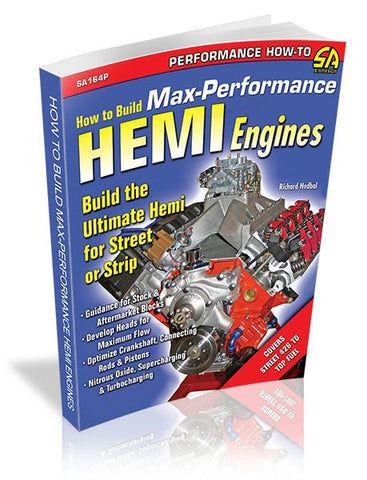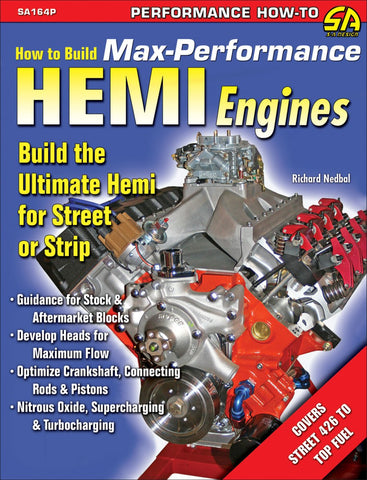Hemi. The word alone evokes images of ultra-high-performance street cars and dominating race cars. No other engine has earned as much street credibility and race success. This engine resides at the pinnacle of American V-8 performance, and cars that carry a Hemi are some of the rarest, most expensive, and legendary muscle cars ever made. When Chrysler threw the wraps off the 426 in 1964, it made history. In the 1964 Daytona 500, the new Hemi-powered stock cars finished 1-2-3-4, announcing Chrysler's new era of dominance in racing. Fast forward to today: recently an immaculate 1970 Plymouth Hemi 'Cuda convertible sold for $2.16 million at a 2006 Barrett Jackson collector car auction. The factory Hemi cars have become legendary, easily eclipsing all other muscle cars in performance and value.
How to Build Max-Performance Hemi Engines details how to extract even more horsepower out of these incredible engines. All the block options from street versus race, new versus old, and iron versus aluminum are presented. Full detailed coverage on the reciprocating assembly is also included. Heads play an essential role in flowing fuel and producing maximum horsepower, and therefore receive special treatment. Author Richard Nedbal explores major head types, rocker-arm systems, head machining and prep, valves, springs, seats, porting quench control, and much more. All camshaft considerations are discussed as well, so you can select the best specification for your engine build. Induction options including EFI, aftermarket ignitions systems, high-performance oiling systems, and cooling systems are also covered. The book also examines in detail how to install and set up power adders such as nitrous oxide, superchargers, and turbochargers.
About the Author
Acknowledgments
Introduction
Special Interview with Tom Hoover
Chapter 1 A Brief History of the Hemi Engine
First-Generation Hemis 1951–1958
The Chrysler 331 and 354
The 392
The End of Early Hemis
Chapter 2 Engine Blocks
The Second-Generation 426 Hemi
2008 Mopar Hemi Block Part Numbers
Block Improvements
Aluminum Blocks
Special Blocks
Chapter 3 The Rotating Assembly
Cast Crankshafts
Forged OEM Crankshafts
Aftermarket Crankshafts
Crankshaft Stroke
Compression Height
Special Finish Work
Recommendations
Crankshaft Journal Size
Magnafluxing
Balancing
Connecting Rods
Aluminum vs. Steel Rods
Pin Size
Pistons
Chapter 4 Bearings
Coatings
Main Bearings
Rod Bearings
Bearing Technical Information
Chapter 5 Heads
Valve Arrangement
Typical Flow Numbers
Iron or Aluminum Heads?
Port Height and Location
Intake and Exhaust Bolt Patterns
Rocker Arm Considerations
Racing Considerations
Head Components
Springs
Head Preparation Sequence
Chapter 6 Valvetrain
The Camshaft
Terminology and the Cam Card
Degreeing a Camshaft
Types of Cams
Special Camshaft Considerations
The Cam Drive
Pushrods
The Rocker System
Indy Cylinder Heads
Rocker Arms
Chapter 7 Lubrication System
Chrysler Hemi Oiling System
Some Technical Comments
Modifications and Improvements to the Oiling System
Block Modifications
Chapter 8 Induction System
Some Induction Basics
Types of Manifolds and Recommendations
Forced Induction
Carburetors
Fuel Types
Fuel Injection
Electronic Fuel Injection (EFI)
Chapter 9 Ignition System
Intermediate Shaft and Bushing
Set the TDC Mark
Hemi Ignition Basics
RPM-Based Mechanical Advance
Load-Based Advance
Rotor Phasing
Effects of Timing on Power
Types of Ignition
Magnetos
Coils
Types of Distributors
Modifying Distributors
Spark Plug Tubes, Wires and Spark Plugs
Chapter 10 Cooling and Exhaust Systems
The Cooling System
The Exhaust System
Chapter 11 Power Adders
Nitrous Oxide
Turbocharging
Power Adder Summary
Chapter 12 Machining and Assembly
The Blueprinting Sheet
Choosing the Parts
Engine Machining
Machining the Rotating Assembly
Machining the Block
Head Machining and Head Assembly
Engine Assembly
Chapter 13 Engine Combinations
Crate Hemi
Stock Street Hemi with Quiet Valvetrain
Normally Aspirated Hot Street Stroker Hemi
Normally Aspirated Hot Street Stroker Hemi with EFI
Supercharged Street Hem
Race Hemi for Bracket Racing
Race Hemi for Top Sportsman Racing
Outlaw Race Hemi
Engine Combination Summary
Chapter 14 On the Dyno
Appendix
Source Guide
Hemi. The word alone evokes images of ultra-high-performance street cars and dominating race cars. No other engine has earned as much street credibility and race success. This engine resides at the pinnacle of American V-8 performance, and cars that carry a Hemi are some of the rarest, most expensive, and legendary muscle cars ever made. When Chrysler threw the wraps off the 426 in 1964, it made history. In the 1964 Daytona 500, the new Hemi-powered stock cars finished 1-2-3-4, announcing Chrysler's new era of dominance in racing. Fast forward to today: recently an immaculate 1970 Plymouth Hemi 'Cuda convertible sold for $2.16 million at a 2006 Barrett Jackson collector car auction. The factory Hemi cars have become legendary, easily eclipsing all other muscle cars in performance and value.
How to Build Max-Performance Hemi Engines details how to extract even more horsepower out of these incredible engines. All the block options from street versus race, new versus old, and iron versus aluminum are presented. Full detailed coverage on the reciprocating assembly is also included. Heads play an essential role in flowing fuel and producing maximum horsepower, and therefore receive special treatment. Author Richard Nedbal explores major head types, rocker-arm systems, head machining and prep, valves, springs, seats, porting quench control, and much more. All camshaft considerations are discussed as well, so you can select the best specification for your engine build. Induction options including EFI, aftermarket ignitions systems, high-performance oiling systems, and cooling systems are also covered. The book also examines in detail how to install and set up power adders such as nitrous oxide, superchargers, and turbochargers.
About the Author
Acknowledgments
Introduction
Special Interview with Tom Hoover
Chapter 1 A Brief History of the Hemi Engine
First-Generation Hemis 1951–1958
The Chrysler 331 and 354
The 392
The End of Early Hemis
Chapter 2 Engine Blocks
The Second-Generation 426 Hemi
2008 Mopar Hemi Block Part Numbers
Block Improvements
Aluminum Blocks
Special Blocks
Chapter 3 The Rotating Assembly
Cast Crankshafts
Forged OEM Crankshafts
Aftermarket Crankshafts
Crankshaft Stroke
Compression Height
Special Finish Work
Recommendations
Crankshaft Journal Size
Magnafluxing
Balancing
Connecting Rods
Aluminum vs. Steel Rods
Pin Size
Pistons
Chapter 4 Bearings
Coatings
Main Bearings
Rod Bearings
Bearing Technical Information
Chapter 5 Heads
Valve Arrangement
Typical Flow Numbers
Iron or Aluminum Heads?
Port Height and Location
Intake and Exhaust Bolt Patterns
Rocker Arm Considerations
Racing Considerations
Head Components
Springs
Head Preparation Sequence
Chapter 6 Valvetrain
The Camshaft
Terminology and the Cam Card
Degreeing a Camshaft
Types of Cams
Special Camshaft Considerations
The Cam Drive
Pushrods
The Rocker System
Indy Cylinder Heads
Rocker Arms
Chapter 7 Lubrication System
Chrysler Hemi Oiling System
Some Technical Comments
Modifications and Improvements to the Oiling System
Block Modifications
Chapter 8 Induction System
Some Induction Basics
Types of Manifolds and Recommendations
Forced Induction
Carburetors
Fuel Types
Fuel Injection
Electronic Fuel Injection (EFI)
Chapter 9 Ignition System
Intermediate Shaft and Bushing
Set the TDC Mark
Hemi Ignition Basics
RPM-Based Mechanical Advance
Load-Based Advance
Rotor Phasing
Effects of Timing on Power
Types of Ignition
Magnetos
Coils
Types of Distributors
Modifying Distributors
Spark Plug Tubes, Wires and Spark Plugs
Chapter 10 Cooling and Exhaust Systems
The Cooling System
The Exhaust System
Chapter 11 Power Adders
Nitrous Oxide
Turbocharging
Power Adder Summary
Chapter 12 Machining and Assembly
The Blueprinting Sheet
Choosing the Parts
Engine Machining
Machining the Rotating Assembly
Machining the Block
Head Machining and Head Assembly
Engine Assembly
Chapter 13 Engine Combinations
Crate Hemi
Stock Street Hemi with Quiet Valvetrain
Normally Aspirated Hot Street Stroker Hemi
Normally Aspirated Hot Street Stroker Hemi with EFI
Supercharged Street Hem
Race Hemi for Bracket Racing
Race Hemi for Top Sportsman Racing
Outlaw Race Hemi
Engine Combination Summary
Chapter 14 On the Dyno
Appendix
Source Guide









